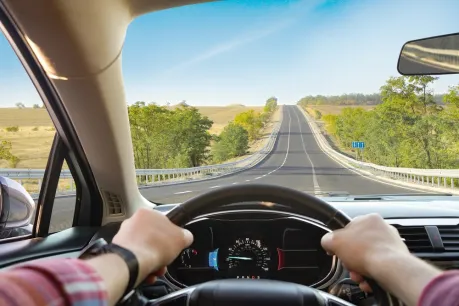Are All Driving Laws in the United States the Same?

Injured?
Please Note: This blog is for educational purposes only and does not constitute legal advice. Driving laws vary by state and may change over time. For the most up-to-date and accurate information, please check your state's Department of Motor Vehicles (DMV) or official government website. If you’ve been involved in an accident and need legal assistance, contact Morgan & Morgan for a free case evaluation.
Driving laws in the United States vary significantly from state to state, reflecting differences in local priorities, road conditions, and governmental regulations.
While federal guidelines provide a baseline for traffic safety, individual states retain the authority to enact their own traffic laws. This can lead to discrepancies in rules governing speed limits, seat belt usage, distracted driving, DUI penalties, and even right-of-way laws.
Understanding these differences is important for drivers who travel across state lines and for those involved in traffic accidents, but sometimes—no matter how much precaution and care we take on the road, accidents can and do happen. If you are involved in an accident that wasn’t your fault, remember to contact Morgan & Morgan. With offices in every state across the country, our legal experts understand the laws and rights surrounding your accident—no matter where it occurs.
Hiring one of our lawyers is easy, and you can get started in minutes with a free case evaluation.
The Variability of Traffic Laws
Speed Limits and Traffic Violations
One of the most noticeable differences in driving laws across states is speed limits. While federal guidelines once mandated a maximum national speed limit of 55 mph, states now have the authority to set their own limits. For example:
- Texas has the highest posted speed limit in the country at 85 mph on certain highways.
- Hawaii enforces some of the lowest highway speed limits, with maximum speeds rarely exceeding 60 mph.
Penalties for speeding also vary. In Virginia, excessive speeding can be classified as reckless driving, carrying hefty fines and possible jail time, whereas in other states, it may result in only a minor fine.
Seat Belt and Child Safety Seat Laws
Seat belt laws differ significantly across states. While all states except New Hampshire require seat belt use, the enforcement varies:
- Primary enforcement: Police can stop and ticket drivers solely for not wearing a seat belt (California, Florida).
- Secondary enforcement: Drivers can only be ticketed for seat belt violations if they are pulled over for another reason (Arizona, Ohio).
Child safety seat laws also differ. Some states require children to remain in a rear-facing car seat until age 2, while others have more lenient requirements.
Distracted Driving Laws
Texting while driving is banned in almost all states, but the degree of enforcement varies:
- Some states, like Georgia, have strict hands-free laws, making it illegal to even hold a phone while driving.
- Others, like Missouri, only ban texting for drivers under 21.
Driving Under the Influence (DUI) Penalties
The legal blood alcohol content (BAC) limit for drivers is 0.08% nationwide, but penalties for DUI offenses vary:
- Arizona has some of the toughest DUI laws, with mandatory jail time and the requirement to install an ignition interlock device for even first-time offenders.
- In contrast, South Dakota has more lenient DUI laws, where first-time offenders often face only a fine and a temporary license suspension.
At-Fault vs. No-Fault Insurance States
States also differ in how they handle car accident liability:
- At-Fault States: The driver responsible for the accident must cover the damages (Texas, California, Georgia).
- No-Fault States: Each driver’s insurance covers their own damages, regardless of who caused the accident (Florida, Michigan, New York).
Unique Traffic Laws in Certain States
Some states have unique traffic laws that can surprise out-of-state drivers:
- Alaska: Drivers must yield to moose crossing the road.
- Oregon: It is illegal to pump your own gas in most areas.
- Hawaii: Driving with a pet on your lap is prohibited.
- California: Lane splitting by motorcyclists is legal, unlike in most states.
Evolving Traffic Laws and Regulations
Laws change frequently to address new safety concerns and technological advances. In recent years, many states have introduced stricter penalties for reckless driving, harsher DUI laws, and new rules governing autonomous vehicles.
For example, in 2021:
- New York implemented tougher penalties for texting while driving.
- California introduced laws to regulate electric scooter usage.
- Florida increased penalties for hit-and-run offenses.
Why Understanding State-Specific Driving Laws Matters
Being unaware of different state driving laws can lead to unintentional violations, fines, or even legal trouble. Additionally, these variations impact liability in car accidents and influence how personal injury claims are handled.
If you’re involved in an accident and are unsure how state laws impact your case, consulting an experienced car accident attorney at Morgan & Morgan can help clarify your rights and legal options.
Frequently Asked Questions
What is the difference between "At-Fault" states and "No-Fault" states?
The difference between "At-Fault" states and "No-Fault" states primarily relates to how car insurance claims are handled after an accident.
At-Fault States (Tort States)
- The driver who caused the accident is responsible for covering the damages (medical expenses, vehicle repairs, lost wages).
- The at-fault driver’s insurance pays for the other party’s damages.
- Injured parties can sue the at-fault driver for additional compensation.
- Common insurance coverage includes liability insurance (to cover damages to others).
No-Fault States
- Each driver’s own insurance covers their medical expenses and related costs, regardless of who caused the accident.
- Personal Injury Protection (PIP) coverage is required, which pays for medical bills and lost wages.
- Lawsuits are generally restricted unless injuries meet a "serious injury" threshold.
Which States Are No-Fault?
As of now, no-fault states include:
- Florida
- Michigan
- New Jersey
- New York
- Pennsylvania
- Hawaii
- Kentucky
- Massachusetts
- Minnesota
- North Dakota
- Utah
Some states, like Kentucky, New Jersey, and Pennsylvania, are "choice no-fault" states, meaning drivers can choose between no-fault and at-fault insurance policies.
Which states have the strictest driving rules?
Several states are known for having the strictest driving laws, based on factors like DUI penalties, speeding enforcement, distracted driving laws, and insurance requirements. Here are some of the strictest:
1. Arizona
- Harsh DUI laws: Even a first offense can lead to jail time.
- Strict penalties for excessive speeding (classified as criminal in some cases).
- High fines and points system for traffic violations.
2. California
- Strong distracted driving laws: Handheld phone use is banned.
- Strict emissions and vehicle safety regulations.
- Heavy penalties for reckless driving and excessive speeding.
3. New York
- Aggressive enforcement of seatbelt and speeding laws.
- Harsh penalties for texting and driving.
- Strict DUI laws with ignition interlock requirements even for first offenders.
4. Massachusetts
- Tough penalties for DUI, including long license suspensions.
- One of the highest insurance rates due to strict enforcement.
- Strict right-of-way laws and pedestrian safety rules.
5. Virginia
- Strict speeding laws: Driving 20+ mph over the limit can be classified as reckless driving (a misdemeanor).
- Harsh DUI laws: Even a first-time offender faces mandatory penalties.
6. Illinois
- Strong DUI penalties: Mandatory breathalyzer use for some offenders.
- Heavy fines for speeding and reckless driving.
- Strict school zone enforcement.
7. Oregon
- One of the toughest distracted driving laws (high fines for phone use).
- Strictest DUI laws, with automatic license suspensions.
- Strong speeding and work zone enforcement.
8. Washington
- Hands-free driving law is strictly enforced.
- Severe DUI penalties, even for first-time offenders.
- Aggressive crackdown on reckless and aggressive driving.
What legal duties do all drivers have in the US?
All drivers in the U.S. have legal duties they must follow to ensure road safety and comply with state and federal laws. These duties generally fall under four key categories:
Duty to Drive Safely
- Obey all traffic laws, including speed limits, stop signs, and signals.
- Avoid reckless driving, such as excessive speeding, tailgating, or aggressive lane changes.
- Yield the right of way when required (to pedestrians, emergency vehicles, or at intersections).
Duty to Remain Alert and Sober
- Avoid driving under the influence (DUI) of alcohol or drugs.
- Stay focused and avoid distractions like texting, eating, or using a handheld device.
- Ensure you are physically and mentally fit to drive (not driving while overly fatigued).
Duty to Maintain Vehicle Safety
- Keep the vehicle in safe working condition, including brakes, tires, and lights.
- Ensure proper registration and insurance are up to date.
- Follow any recall notices or necessary repairs for safety issues.
Duty to Stop and Report Accidents
- If involved in an accident, stop immediately and provide assistance if needed.
- Exchange insurance and contact information with other drivers.
- Report serious accidents to law enforcement, as required by state law.
Failure to follow these duties can lead to traffic violations, fines, license suspension, lawsuits, or even criminal charges.
When should you hire an attorney for a car accident?
No matter where your accident happens, you should consider hiring an attorney if:
- You suffered serious injuries.
- Liability is disputed.
- You are dealing with insurance disputes or denied claims.
- You need help negotiating a fair settlement.
For expert legal assistance, Morgan & Morgan is here to fight for your rights and ensure you receive the compensation you deserve. Contact us today for a free case evaluation to learn more about your legal options.

We've got your back
Injured?
Not sure what to do next?
We'll guide you through everything you need to know.
